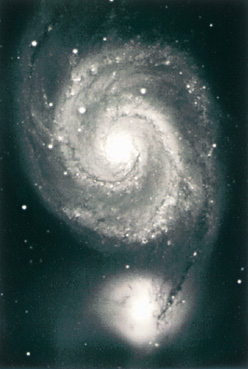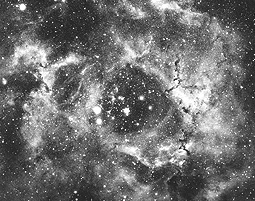|
ST-4 CCD STAR TRACKER & |
| CCD Imaging Cameras | ST-237A | ST-5C | ST-6B | ST-7XE | ST-8XE | ST-9XE | ST-10XE | ST-1001E | ST-2000XM |
| Video Camera / Autoguider | |||||||||
| Industrial / Scientific | |||||||||
MODEL ST-4 |
|
ST-4 CCD STAR TRACKER & |
[Note April 11, 2001: This page is for technical information only. We have discontinued the ST-4 and are now sold out of our remaining stock. For the next generation of autoguider / imaging camera please see the STV.]
Very few instruments have had the dramatic effect on astrophotography as the Model ST-4
CCD Imaging Camera/Autoguider. This thermoelectrically cooled CCD imaging camera is
actually a dual purpose instrument that can be used as an automatic Star Tracker to take
long guided exposures of the night sky or, in conjunction with a personal computer; as an
introductory level Imaging Camera displaying 8 bit digital images. The internal
cooling of the CCD reduces the detector thermal noise and significantly improves the
ability to guide on dim stars. The ST-4 is easy to use and will automatically track a
guide star for professional quality astrophotographs, measure stellar magnitude, perform
as a blink comparator or record images of galaxies.
When located at the prime focus of either a guide telescope or the primary telescope, the
Model ST-4 generates control signals for guiding a telescope in Right Ascension and
Declination. In operation a guide star is focused on the CCD detector; which consists of
an array of elements, called pixels. These pixels, which are arranged in horizontal and
vertical rows, convert photons into electrons. When a guide star's image is present at a
specific pixel the ST-4's microcontroller will note the increased signal from that pixel.
If the star is drifting it will appear at a different pixel in the next exposure. The
microcontroller then calculates how far the star has drifted and generates a control
signal to correct the position. The control signal's duration is a function of how far the
star has drifted. The microcontroller can take an exposure, read out all of the pixel
values, and calculate the necessary telescope correction in less than a second.
The ST-4 has a CALIBRATE mode in which the internal software automatically drives the
telescope in all four directions sequentially. During this mode the ST-4 determines the
amount of correction necessary to move the guide star one pixel in the North, South, East
and West directions of the field of view. Once the CALIBRATE function has been completed
the user presses the TRACK button and the ST-4 acquires a fresh star image, centers the
image on a pixel and holds that star in position by constantly monitoring it and sending
correction signals to the telescope drive immediately after each exposure.
 |
| M51. Seven 1200 second Model ST-7 CCD images summed together and taken at the prime focus of a Celestron C14 at f/7. |
The ST-4 is thermoelectrically cooled to enhance its sensitivity to dim stars. This
extreme sensitivity enables guide stars as faint as 8th magnitude to be tracked utilizing
a 60 mm guide telescope and 12th magnitude with a 20 cm aperture. The rapid calculating
power of the microcomputer enables the guide star location to be determined within a
fraction of a pixel, enabling better than 1 arcsecond tracking accuracy.
 |
| NGC2244. Two 60 minute integrated Model ST-4 autoguided astrophotographs taken on Tech Pan Film with a 120 format camera. |
In the IMAGING mode, when used in conjunction with a PC or Macintosh, the ST-4 will record
and display 8 bit digital images that are "seeing" limited. It can be used
for imaging faint galaxies, measuring the angular separation and orientation of close
binary stars or determining the magnitude of any star within its field-of-view. A cable is
provided to connect the Model ST-4 to the serial port on the host computer as is software
to automatically configure the port. The microcontroller in the ST-4 is instructed to take
an exposure by the host computer and to store the data in its internal memory. Complete
control of the imaging camera is through the computer keyboard. The data is then
transmitted over the RS-232 serial link at speeds up to 57.6K baud to the computer where
it can be displayed and saved to the disk. A full image consists of 31872 bytes and is
digitized to 8 bit accuracy.
The ST-4 now includes several additional software programs which greatly expand on it's
capabilities as a stand alone autoguider. When connected to a computer or laptop via
the serial port, the ST-4 becomes a versatile instrument. For remote operation the
ST-4 now comes with CCDTRACK software which allows the user to
perform all of the ST-4's stand alone guiding functions from a remote computer. CCDTRACK software also includes several enhancements to the ST-4's
guiding capabilities. Remote control is very useful for observatory work or any
application where the user wishes to manage the autoguider and telescope from more than a
few feet away. CCDBLINK software allows the ST-4 to be
used as a very accurate blink comparator as might be used for asteroid hunting, comet
tracking, etc. CCDUTIL software contains image processing utilities and special file
utilities for interchanging image files from the ST-4 with other programs. The
utilities include image translation and rotation with sub-pixel accuracy, flat field
correction of images, filtering and scaling.
The Model ST-4 is in world wide use. It has become the standard for precision telescope guiding. It is also a good low cost introductory imaging camera, but the autoguiding is the major feature of this product. Call us with questions about interfacing it to your telescope.
Model ST-4 CCD Specifications
| CCD | TI TC-211 |
|---|---|
| Pixel Array | 192 x 164 pixels, 2.6 x 2.6 mm |
| Total Pixels | 31,000 |
| Pixel Size | 13.75 x 16 microns |
| Full Well Capacity | 80,000e |
| Dark Current | 250eŻ/pixel/sec at 0° C |
| Antiblooming | Variable Rate |
Readout Specifications
| Shutter | None |
|---|---|
| Exposure | 0.01 to 300 seconds, 10ms resolution |
| Correlated Double Sampling | No |
| A/D Converter | 8 bits + 2 bit Gain Select |
| A/D Gain | 150eŻ/ADU |
| Read Noise | 150eŻ RMS |
| Binning Modes | 1 x 1 |
| Pixel Digitization Rate | 100 kHz |
| Full Frame Acquisition | under 6 seconds |
Optical Specifications (8" f/10)
| Field of View | 4.5 x 4.5 arcminutes |
|---|---|
| Pixel Size | 1.4 x 1.6 arcseconds |
| Limiting Magnitude | Magnitude 11 in 1 second |
| (for 3 arcsec FWHM stars) | Magnitude 16 in 1 minute |
System Specifications
| Cooling | Single Stage Thermoelectric |
|---|---|
| Temperature Regulation | Unregulated |
| Power | 12 V AC/DC 1 amp, Transformer included |
| Computer Interface | Serial (RS-232) |
| Computer Compatibility | PC - MS-DOS, Macintosh |
| Guiding | Stand-alone Autoguiding |
Physical Dimensions
| Optical Head | 3 in. diameter x 1.5 in. deep 0.5 pounds/0.2 Kg |
|---|---|
| CPU | 6 x 9 x 2 inches / 15 x 23 x 5 cm 2 pounds/0.9 Kg |
| Mounting | 1.25 Inch Draw Tube |
| Backfocus | 0.04 inches/0.1 cm |
Revised: April 10, 2002 01:36:12 PM.
Copyright © 1998 Santa Barbara Instrument Group, Inc. All rights reserved.
Please report any problems with this page directly to the Webmaster